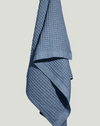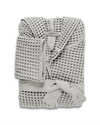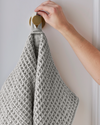Education
Turkish vs Egyptian Cotton: Which Is Better?
Published
August 14, 2024
Reviewed by
Suze Dowling

When selecting the perfect cotton for your home textiles, the choice can be overwhelming. From towels and bed sheets to bathrobes and luxury clothing, the quality of cotton you choose can significantly impact your comfort and satisfaction.
Among the most sought-after types of cotton are Turkish and Egyptian cotton, both known for their exceptional quality and luxurious feel. But which one is truly better? In this article, we aim to unravel the differences between Turkish and Egyptian cotton, providing a comprehensive comparison to help you make an informed decision.
Whether you're looking for the ultimate in softness, durability, or absorbency, understanding the unique characteristics of each type of cotton will guide you in choosing the right one for your needs.
What Are the Different Cotton Types?
Before diving into the specifics of Turkish and Egyptian cotton, it’s essential to understand what makes cotton varieties different and why quality matters. Cotton is classified based on the length of its fibers, also known as staples. The longer the fibers, the higher the quality of the cotton, resulting in a smoother and stronger fabric.
There are several types of cotton grown around the world, each with its own set of characteristics:
-
Upland Cotton: This is the most common type, making up about 90% of the world’s cotton production. It has short to medium-length fibers and is often used in everyday clothing and household items.
-
Pima Cotton: Known for its extra-long staple fibers, Pima cotton is soft, durable, and often used in high-end products.
-
Supima Cotton: A trademarked brand of Pima cotton grown in the United States, Supima represents the highest quality Pima cotton.
- Organic Cotton: Grown without synthetic pesticides or fertilizers, organic cotton offers an environmentally friendly option.
Among these, Turkish and Egyptian cotton stand out due to their long fibers and superior quality. These two types of cotton have been revered for centuries for their luxurious feel and durability, making them a popular choice for premium textiles.
Understanding the distinct characteristics and benefits of Turkish and Egyptian cotton will help you determine which is better suited for your specific needs, whether it's for towels that dry quickly and resist mildew or bed sheets that provide a soft, comfortable sleep.
In the following sections, we will delve into the origins, properties, and practical applications of each type to provide a clear and detailed comparison.
What Are the Origins of Turkish and Egyptian Cotton?
Understanding the origins and historical significance of Turkish and Egyptian cotton is important to truly appreciate their qualities.
Background of Turkish Cotton
Turkish cotton originates from the Aegean region of Turkey, which is known for its fertile soil and ideal growing conditions. The history of Turkish cotton dates back centuries, with artisans perfecting the art of weaving to produce luxurious textiles.
Turkish cotton has been a staple in Turkish baths (hammams) for centuries, valued for its absorbency and softness. The unique climate and soil of the Aegean region contribute to the long fibers and high quality of Turkish cotton, making it a preferred choice for towels and bathrobes.
Background of Egyptian Cotton
Egyptian cotton, on the other hand, is grown in the Nile River Valley. The region’s rich soil and consistent, favorable climate create the perfect environment for growing long-staple cotton. Egyptian cotton has a long-standing reputation for being the finest in the world, with its cultivation dating back to the time of the Pharaohs.
Known for its incredible softness and strength, Egyptian cotton became highly sought after in the global market, often used in luxury bed linens and high-end clothing. The meticulous hand picking process ensures that the fibers remain intact, contributing to the superior quality of the cotton.
What Are the Characteristics of Turkish Cotton?
Turkish cotton is renowned for its long fibers, which enhance the strength and durability of the fabric by reducing the number of joins. This results in a smoother, more resilient textile capable of withstanding frequent use and washing.
Additionally, Turkish cotton is celebrated for its excellent absorbency, letting it quickly soak up water, making it ideal for towels, and helping to prevent mildew and odors. Striking a perfect balance between durability and softness, Turkish cotton becomes softer with each wash, making it a popular choice for bathrobes and towels that offer both luxury and functionality.
What Are the Characteristics of Egyptian Cotton?
Egyptian cotton is renowned for its superior quality and luxurious feel, largely due to its extra-long staple fibers. These long fibers produce a finer, smoother, and stronger yarn, contributing to the fabric's exceptional durability and ability to withstand frequent washing without losing integrity.
The silky, smooth texture of Egyptian cotton makes it an excellent choice for bed linens and clothing, enhancing comfort and luxury. Additionally, its long fibers and strength make Egyptian cotton highly durable and resistant to pilling, ensuring that textiles maintain their smooth, luxurious appearance over time.
What Is the Difference Between Turkish and Egyptian Cotton?
When comparing Turkish and Egyptian cotton, several factors come into play. Here's how they stack up against each other in key areas:
Softness & Comfort
Both Turkish and Egyptian cotton are known for their softness, but they achieve this in different ways. Turkish cotton becomes softer with each wash, making it an excellent choice for towels and bathrobes that need to be absorbent and gentle on the skin.
Egyptian cotton, with its long staple fibers, provides a naturally silky and smooth texture, making it ideal for bed linens and luxury clothing where a soft feel is paramount.
Durability & Longevity
Egyptian cotton is generally more durable due to its longer fibers and stronger yarn. It is less prone to pilling and can maintain its quality over many years of use.
Turkish cotton, while also durable, is designed to be softer and more absorbent, which may result in a slightly shorter lifespan compared to Egyptian cotton. However, both types of cotton are capable of lasting a long time with proper care.
Absorbency & Drying Time
Turkish cotton is highly absorbent and quick-drying, making it perfect for towels and bathrobes that need to dry quickly between uses. This feature helps prevent mildew and odors, keeping the textiles fresh.
Egyptian cotton is also absorbent but tends to dry more slowly due to its dense weave and higher thread count. This makes it better suited for applications where a luxurious feel is more important than quick drying, such as bed linens.
Maintenance & Care
Both Turkish and Egyptian cotton require proper care to maintain their quality. Egyptian cotton should be washed in cold or warm water and dried on a low setting to prevent shrinkage and damage.
Turkish cotton can be washed and dried more easily, often becoming softer with each wash. Regular care and attention will ensure that both types of cotton remain in excellent condition for years.
Price & Value
Egyptian cotton is typically more expensive than Turkish cotton due to its longer fibers and more labor-intensive harvesting process. The higher price reflects the superior quality and luxurious feel of Egyptian cotton textiles. Turkish cotton offers excellent value for the money, providing a balance of softness, absorbency, and durability at a more affordable price point.
The Takeaway
Choosing between Turkish and Egyptian cotton depends on your specific needs and preferences. Turkish cotton excels in absorbency and quick-drying properties, making it ideal for towels and bathrobes. Egyptian cotton offers unparalleled luxury, durability, and softness, making it perfect for bed linens and high-end clothing.
At Onsen, we understand the unique benefits of each type of cotton, which is we offer a diverse line of bathroom linens to cater to various preferences. Our Waffle towels, made from 100% USA-grown extra-long staple Supima cotton, dry three times faster than regular towels, preventing mildew and ensuring long-lasting freshness.
Our Plush line, crafted from 100% Turkish-grown Aegean cotton, combines absorbency with a luxurious feel, providing a perfect balance of comfort and functionality. Whether you prioritize quick-drying practicality or sumptuous softness, our thoughtfully designed products ensure you can enjoy the best of both worlds, enhancing your daily routines with high-quality, durable, and luxurious bathroom linens.
Sources:













